Adrian Collins's Blog, page 104
March 7, 2023
REVIEW: Quantum Radio by A.G. Riddle
Quantum Radio is the newly released multiverse thriller by A.G. Riddle centering on Dr. Tyson Klein, an American particle physicist working at CERN in Geneva. Ty’s research at the Large Hadron Collider leads to a breakthrough discovery in quantum mechanics pointing to the existence of a parallel universe. Ty detects an encoded signal from a type of quantum radio, which he believes contains an important message. He is determined to decode this message, both for the advancement of science and, potentially, for the benefit of humankind.
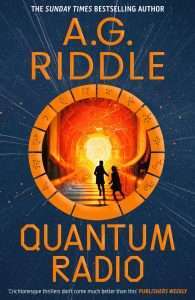 Ty’s discovery of the quantum radio is an astonishing scientific breakthrough. However, when he presents his work at a scientific conference, Ty immediately becomes the target of a shadowy organization known as the Covenant. With his life in danger, Ty flees to the safety of his estranged parents and the U.S. government.
Ty’s discovery of the quantum radio is an astonishing scientific breakthrough. However, when he presents his work at a scientific conference, Ty immediately becomes the target of a shadowy organization known as the Covenant. With his life in danger, Ty flees to the safety of his estranged parents and the U.S. government.
The scientific premise of Quantum Radio is quite interesting, and I rather enjoyed the first several chapters of the book. Unfortunately, it’s all downhill from there as the plot devolves into a sequence of unbelievable coincidences. Moreover, the intricacies of the quantum radio are deciphered rather arbitrarily through Ty’s intuition rather than any compelling scientific arguments.
Quantum Radio is a fast-paced thriller that recalls Michael Crichton with its no-frills narrative style. A.G. Riddle maintains an even pace over the book’s 113 short chapters.
Regrettably, Quantum Radio strays too far from its sci-fi premise, becoming more of an alternate historical fiction where the Nazis won World War II and plunged the world into an extended period of darkness and oppression. The second half of Quantum Radio has more in common with the dystopian alternate history of The Man in the High Castle than with any science fiction novel.
Quantum Radio also suffers from unrealistic dialogue that features characters telling each other things they already know, solely for the benefit of the reader. For example, these supposedly world-leading physicists have a habit of describing basic scientific concepts to each other that they should have all learned as undergraduate students.
But the most cringeworthy scenes occur in the second half of the book, where characters read pages worth of text from museum exhibits at the National Museum of American History in Washington, D.C. With all this extended info dumping, I felt like I was reading an entry in Mary Pope Osborne’s Magic Tree House children’s book series, but with more Nazis.
Ultimately, Quantum Radio falls short of its Crichtonesque aspirations, spoiling an interesting premise by straying too far from its sci-fi roots and by relying too much on awkward dialogue-driven exposition and an overly contrived plot. Grimdark readers with an appetite for mind-bending multiverse science fiction are advised to look elsewhere.
2/5
Read Quantum Radio by A.G. RiddleThe post REVIEW: Quantum Radio by A.G. Riddle appeared first on Grimdark Magazine.
March 6, 2023
REVIEW: The Faithless by C.L. Clark
The Faithless follows C.L. Clark’s debut with bloody politics you can cut your teeth on, queer women with sharp swords, intense action, and tense relationships reminiscent of harsh realities. It all starts off where The Unbroken left off. Qazal is now being led by a council. Touraine, an Ambassador to Balladaire, is begrudgingly traveling to Balladaire. Luca, per usual, is once again conniving for her throne. This, of course, is more difficult than she expected with her uncle pushing chess pieces in the precise positions, so every courtier worth their salt is seduced against her, and he can continue sitting on the throne in all the arrogant majesty Balladaire has to offer its hopeful king.
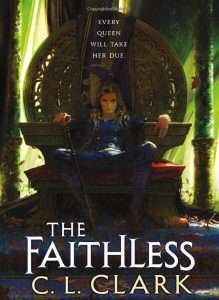 Set mostly in Balladaire, The Faithless has got all the glitz and bloody glamour of court fashion, extremely gay drunk aristocrats, and duels at parties readers could ever want. Sabine, a “spoiled marquise,” remains a shining light throughout the whole thing. I am enamored of her witticisms, especially when elegantly holding a sword or a drink. Beneath all that refinery is the rotting corruption making the Balladairan empire’s colonizer mess look like decrepit Viserys Targaryen later in House of the Dragon.
Set mostly in Balladaire, The Faithless has got all the glitz and bloody glamour of court fashion, extremely gay drunk aristocrats, and duels at parties readers could ever want. Sabine, a “spoiled marquise,” remains a shining light throughout the whole thing. I am enamored of her witticisms, especially when elegantly holding a sword or a drink. Beneath all that refinery is the rotting corruption making the Balladairan empire’s colonizer mess look like decrepit Viserys Targaryen later in House of the Dragon.
Touraine is still trying to unclench her jaw that she’s been tasked with forming an alliance with Luca, who she justifiably wants to stomp into the ground most of the time. She’s willing to assist in Luca’s political games to win the court’s favor if it means ensuring Qazal gets their due. The intimate way C.L. Clark writes about Touraine’s relationship with colonialism remains deeply uncomfortable and also very brilliant. Touraine’s attraction to Luca is a big part of that complicated relationship with politics and personal relationships. Balladaire trained her in their culture and education. This place is a part of her identity, including her tragic origin on its shores. But Luca’s ancestors are also the reason Touraine’s people are treated with inferior rights to Balladaire. That chilling exploration between what readers want to see and what people feel gives Clark’s writing such a brutal edge. While characters are surely neither purely good nor bad, The Faithless intentionally shows with great intensity the actions of colonizers in a narrative that neither forgives, softens, or redeems. The characters are looked at with unflinching detail, reflecting a mirror to onlookers.
I did find my interest wandering a bit toward the seventy percent mark. Clark’s subplots tended to meander too much. I am also not convinced that we needed Fili’s chapters. There could have been more tightening up during edits to prevent a loss in that engagement. The Faithless is a great follow up, but I can’t say this is as good as The Unbroken, which I feel is the stronger of the two. I hope to see a strong ending to the Magic of the Lost trilogy.
It will be no surprise to fantasy readers that Clark pulls no punches. The Faithless is more of a murderous political court intrigue novel than the war-torn debut, but it goes into the deadliest, coldest corners of the mind. Readers should expect to go in with open scars. Even though I knew the end was soon in sight, I wanted to know more about what would happen next. What horrible, insightful thing will happen in this harrowing world that readers have yet to be surprised by? The Faithless is the antithesis of enchantment, spinning grim and grit, which is exact perfection for readers that love their pain with a bit of heart.
Rating: 4 stars
Read The Faithless by C.L. ClarkThe post REVIEW: The Faithless by C.L. Clark appeared first on Grimdark Magazine.
March 5, 2023
REVIEW: Don’t Fear the Reaper by Stephen Graham Jones
Proofrock, Idaho, is a small town marred by tragedy. The Independence Day Massacre that concluded My Heart is a Chainsaw, the first novel of Graham’s Indian Lake Trilogy, claimed more than a dozen lives. Eyewitness accounts of the chaos differed dramatically, but misfit high school senior Jennifer “Jade” Daniels found herself saddled with at least some of the blame. Volume 2 of the trilogy, Don’t Fear the Reaper begins four years after the bloodbath. Released from prison after a mistrial, Jennifer returns to the only home she’s ever known. While deep in her heart she knows that the nightmare isn’t over, that a legendary threat remains at large, she yearns to put the past behind her. But small towns have long memories, and everywhere she turns she finds herself confronted by the scarred and the grieving. Complicating matters even further is that her slouching return coincides with the blizzard-aided escape of Dark Mill South, an enigmatic serial killer hoping to add a few more bodies to his count.
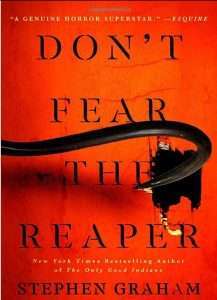 Winner of the Bram Stoker award for Superior Achievement in a Novel, My Heart is a Chainsaw introduced readers to Jade Daniels, an angry and rebellious half-Indian girl with an encyclopedic knowledge of slasher movies. While much of the first book centered on her use of horror flick trivia to recognize and deal with a lethal menace in her hometown, it was also an achingly empathetic portrait of a deeply hurt and isolated young woman trying to make her way in an insular community that didn’t seem to have any place for her. She is, as Jones aptly sums up, a girl whose feelings are too big for her body. Don’t Fear the Reaper presents a slightly matured version of Jones’ Final Girl. She prefers to be called Jennifer now, not Jade. And after living through a very real nightmare, scary movies have lost their luster. Despite her attempts to move on, however, to the citizens of Proofrock she’s still the same old Jade. Circumstances also conspire to mire her in the past, as once again she finds herself in a real-life horror movie where knowing the tropes and rules of the game can mean the difference between living to see another day and joining the rapidly expanding ranks of the dead. Burying the past is a luxury she may not have.
Winner of the Bram Stoker award for Superior Achievement in a Novel, My Heart is a Chainsaw introduced readers to Jade Daniels, an angry and rebellious half-Indian girl with an encyclopedic knowledge of slasher movies. While much of the first book centered on her use of horror flick trivia to recognize and deal with a lethal menace in her hometown, it was also an achingly empathetic portrait of a deeply hurt and isolated young woman trying to make her way in an insular community that didn’t seem to have any place for her. She is, as Jones aptly sums up, a girl whose feelings are too big for her body. Don’t Fear the Reaper presents a slightly matured version of Jones’ Final Girl. She prefers to be called Jennifer now, not Jade. And after living through a very real nightmare, scary movies have lost their luster. Despite her attempts to move on, however, to the citizens of Proofrock she’s still the same old Jade. Circumstances also conspire to mire her in the past, as once again she finds herself in a real-life horror movie where knowing the tropes and rules of the game can mean the difference between living to see another day and joining the rapidly expanding ranks of the dead. Burying the past is a luxury she may not have.
Not only does Jennifer remain a captivating heroine, Jones extends his empathy to the surrounding cast of characters as well. Where the first book dealt with one traumatized girl, Don’t Fear the Reaper shows us a traumatized community. Horror movies usually end with the monster’s death, we’re spared the aftermath. But Proofrock is a small town. The loss of so many during the Independence Day Massacre is still keenly felt years later, and to each other the survivors are living reminders of the tragedy. The former sheriff now relies on a walker. The town beauty struggles with an ongoing regimen of prescription medications and reconstructive surgeries. Not all of the characters whose minds we’re invited into are sympathetic, some are fairly reprehensible, but Jones doesn’t play favorites. He makes us understand their motives, their regrets, their aspirations. (And then has them murdered in graphic, inventive ways worthy of the best slasher films.) For this reader, the humanity with which the characters are portrayed was the highlight of the book.
Both volumes share masterful characterization, but Don’t Fear the Reaper differs significantly from its predecessor in terms of pacing. Much of My Heart is a Chainsaw is a slow burn, but this follow- up volume is remarkably compressed. Excluding flashbacks, postscripts, and other asides, the heart of the book takes place in a matter of hours. The struggle for survival is absolutely relentless. Where before Dark Mill South’s killings may have been serial in nature—with victims separated by time and geography—when he arrives in Proofrock he launches an all-out spree. Cut off from the outside world by inclement weather, with power and phone lines failing, the residents of town find themselves immersed in a new massacre, one that many are fatally oblivious that is even occurring.
While Dark Mill South displays a degree of fortitude worthy of movie slashers Jason Voorhees and Michael Myers, as in My Heart is a Chainsaw many of the supernatural elements mentioned in Don’t Fear the Reaper remain tantalizing, more often hinted at than foregrounded. Not all of our narrators are reliable, and quite frequently these witnesses are amped up on adrenaline or mortally wounded during their brushes the otherworldly. During these passages, Jones switches to a more gauzy, impressionistic style that requires one to read between the lines. It seems that there are phantasmal elements in play even beyond the legendary Lake Witch described in the first volume. Questions remain unanswered, but the dots the reader are given to connect have begun taking on an intriguing shape.
Like Pulitzer Prize winner Michael Chabon, Stephen Graham Jones balances serious literary chops with an unashamed love of genre fiction. Both My Heart is a Chainsaw and earlier stand-alone novel The Only Good Indians (2020) have attracted accolades both within and outside the horror fiction community, and Don’t Fear the Reaper seems destined to enjoy the same recognition. It’s a satisfying follow-up that leaves one exhilarated and excited for the trilogy’s conclusion. Part of me wonders if three volumes is enough, however. As any scary movie fan can tell you, the best franchises have a habit of outgrowing trilogies.
Read Don’t Fear the Reaper by Stephen Graham JonesThe post REVIEW: Don’t Fear the Reaper by Stephen Graham Jones appeared first on Grimdark Magazine.
March 4, 2023
REVIEW: Mandy
Mandy (2018) is an interesting experiment in movie film-making. It’s a fairly typical revenge plot movie where a man has his wife murdered and he proceeds to hunt down and kill everyone involved. It’s a plot that has been done hundreds, if not thousands, of times. However, the movie’s style is something that needs to be seen to be believed. The music, the lighting, the atmosphere, and the characterization turn an otherwise bog-standard story of grief-fueled vengeance into a psychadelic journey through Hell. I would say it is a horror movie, revenge pic, and drug journey all in one.
In the Shadow Mountains of Eastern California, Red Miller (Nic Cage) and his girlfriend, Mandy (Andrea Riseborough) are living a tranquil existence. Red is implied to be someone who used to be extremely violent as well as an alcoholic and substance abuser. He has gotten himself clean, though, and there’s no history of abuse with his girlfriend. Still, even before everything goes to Hell, there’s a slow sense of dread that he is someone who could very easily fall off the wagon into some place nightmarish.
Unfortunately, living nearby is a hippie pseudo-Christian cult led by Jerimiah Sand (Linus Roache) who is obviously based on Charles Manson. He’s a failed musician, teaches an utterly nonsensical ministry based on pleasure, and abuses his female followers psychologically as well as physically. Sand gets one look at Mandy while passing her in his car and decides he needs to get her to be his sex toy.
That’s when things get weird in a way that David Lynch would be proud of and do director Panos Cosmatos proud. Sand calls a group of Satanic bikers to him using an ocarina, offer them a blood sacrifice, and they kidnap Miller as well as Mandy. Mandy is shot full of drugs and killed after mocking what a pathetic piece of garbage Sand is despite being higher than a space shuttle. Miller is dumped out with the trash and proceeds to gather his head after a short period of mourning. What follows is utter insanity as he hunts down the bikers as well as Sand.
Weirdly, Mandy works very well as a modernization of Conan: The Barbarian. Miller is a guy who lives in the wood who used to be a savage warrior and thief but has retired. Sand is a Thulsa Doom-esque cult leader who has the allegiance of a bunch of genuinely dangerous warriors as well as raiders to aid his cult.
There’s even a scene where Miller forges himself a battle ax to help in his killing of the bikers. The bikers, themselves, are Satanic in a way that might be supernatural as they speak in “monster voice” while knowing things they could not possibly know. It’s also possible they’re just a bunch of guys who fried their brains on bad LSD as one friend of Miller speculates. Miller may be haunted by his dead wife’s ghost or he might simply be hallucinating due to trauma, head injury, and sampling the bikers’ batch of crazy powder.
There’s some truly fantastic scenes throughout Mandy. Nic Cage has had some terrible performances in his career but his combination of understated performance before going into bizarre hammy over-the-top weirdness works well for a guy who is literally on drugs while suffering from horrific trauma. Which is to say Nic Cage is great whenever he’s playing someone who there is just not something right with.
It’s a great movie if you can look past the fact Mandy is one of the best characters and the film suffers without her. It’s the kind of film that would have been made in the Eighties only it’s been done better here. There’s even subtle details that would be lost in a less skilled filmmaker’s hands like the fact Mandy owns a bunch of Eighties metal t-shirts and Sand tries to impress her with his awful folk rock.
The post REVIEW: Mandy appeared first on Grimdark Magazine.
March 3, 2023
REVIEW: Alice in Borderland Season 2
Continuing the crazy Japanese sci-fi murder-fest set in a death-filled Tokyo, Alice in Borderland S2 ups the ante from the brilliant first season and delivers an even better second season as Arisu and friends attempt to escape their hellish version of Tokyo by completing the games set before them in the hope that they can return to the world they once knew.
Survival games always feel quite popular for TV and Film. Battle Royale, Hunger Games, Squid Game – we’ve seen inventive ways of killing off men and women for quite some time now, but the boredom will never set in if shows take the time to make the audience care for the characters whilst still providing incredibly unique ways of dispatching the poor folk like they do in Alice in Borderland S2. I have to admit, I was unsure if the show could pull off the second season following the surprisingly brilliant first one. With Arisu’s best friends dead and those relationships now lost to the show, I wondered if I would care about any newcomers or blossoming relationships. In the end, I cared far more. I invested in Arisu, Usagi, Chishiya, and Kuina as they attempted to solve the mystery of the Borderland and beat the remaining games – all face level difficulty (the hardest yet). I cared about each character and their strengthening relationships and this ramped up the tension as they face deadlier challenges throughout the season, with death always a breath away. Chishiya became my favourite character of the season. He is the Cheshire Cat of this play on Alice in Wonderland, always smirking as he watches and analyses his fellow competitors. He is the epitome of cool and he also gets the best survival games. One in particular involves trusting fellow competitors to tell you which card suit you belong to and wrong answers lead to a Battle Royale style head explosion. It is one of the best episodes on TV this year.
The games in Alice in Borderland S2 are a step up from the previous series. They are bloodier, more dramatic, and tenser than I believed possible. The pace of the games is perfect. The action may ramp up for a moment but it slows down when needed to give more depth to characters and their plight in this strange Tokyo. Arisu grows as a character and learns to move on from his past and work together with his new friends to do his best to escape the hell they are in. More money has been spent on this season with better tech for the unwilling contestants and games to show off the sci-fi elements of the show but it is great to see that the writing still focuses on character depth and unravelling the mystery. The season finishes without a need for a third, creating a brilliant two season series with a definitive ending that fans can enjoy without the show dragging on.
Alice in Borderland S2 is darker, bloodier, but more hopeful than its first season. You’ll come for the bloody death games but you’ll stay for the excellent characters. Alice in Borderland S2 is a series that focuses on how important friends are in keeping on a light to shine in the darkness when things get too tough. A perfect message for people going through difficult times.
The post REVIEW: Alice in Borderland Season 2 appeared first on Grimdark Magazine.
March 2, 2023
REVIEW: Barrow of Winter by H.M. Long
Barrow of Winter is the third book set in H.M. Long’s Hall of Smoke world. Although Barrow of Winter could be viewed chronologically as the third book in the series, it feels more like a standalone title. So although a knowledge of the other novels in this series may offer a greater understanding of the “historical” events that Long makes the odd reference to in Barrow of Winter, they are not essential reading. A reader could easily enjoy this latest novel without prior knowledge as it is set well over a decade from the ending of Temple of No God. The main characters in the earlier books play a minor role in this.
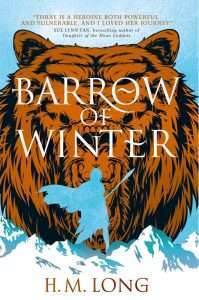 Set in a Viking-inspired land, Barrow of Winter is an epic fantasy novel with a single narrative point of view from Thray, the last daughter of Ogam, who was part of the pantheon of gods in Long’s world. His death occurs in Long’s first novel, but that and any other relevant details are summarised as part of the story in Barrow of Winter, which is why you do not have to have read the previous novels. Long is excellent at world-building, in particular, the religion and history of this world, which played a much more significant part in the first two novels than they do in this one. Thray is both a demi-god and a warrior priestess, struggling to find her place in a society where she does not seem to fit. I felt this made Barrow of Winter feel a bit more like a coming-of-age saga than a truly epic fantasy, but Long’s writing is compelling and flows well. I finished it in a few days, which is a rare feat for me.
Set in a Viking-inspired land, Barrow of Winter is an epic fantasy novel with a single narrative point of view from Thray, the last daughter of Ogam, who was part of the pantheon of gods in Long’s world. His death occurs in Long’s first novel, but that and any other relevant details are summarised as part of the story in Barrow of Winter, which is why you do not have to have read the previous novels. Long is excellent at world-building, in particular, the religion and history of this world, which played a much more significant part in the first two novels than they do in this one. Thray is both a demi-god and a warrior priestess, struggling to find her place in a society where she does not seem to fit. I felt this made Barrow of Winter feel a bit more like a coming-of-age saga than a truly epic fantasy, but Long’s writing is compelling and flows well. I finished it in a few days, which is a rare feat for me.
Thray’s restlessness is what triggers her and a small group of her fellow Eangen warriors to travel north to meet the rest of Thray’s immortal demi-god siblings in the frozen northern wasteland of Duamel. Her journey north begins with the deception of her friends, and there are further layers of duplicity to be found as she travels northwards. Thray does not know who to trust, and nor do we the reader, and this intrigue and slow reveal was one of my favourite parts of the novel. Long’s writing is atmospheric and detailed; it is a great story to curl up with (particularly in the darker winter evenings, so it is very apt in that respect), but it is not the grimmest or darkest of novels out there. There are some perilous moments, some gory bits, and the novel’s final battle was an excellent conclusion, but it does not quite tick the dark fantasy box.
That said, however, it was a good read. I enjoyed it, and I was entertained for the time I spent reading it. I like Long’s world, and I am glad to have been able to return to it and look forward to the fourth novel set in this world Pillar of Ash, which is due out sometime in 2024. Barrow of Winter might not be for everyone following the Grimdark Magazine reviews, but it will be a worthwhile reading investment for some. If you liked Long’s other works, picking this up should be a no-brainer; you will enjoy it. If you are a bit on the fence but like female-led fantasy, with minimal faffy romance stuff, some magic, and battles (but not overly violent) then you will have a good time settling down with Barrow of Winter. I certainly did! So thank you very much to H.M. Long and the team over at Titan for
sending me a copy.
4/5.
Read Barrow of Winter by H.M. LongThe post REVIEW: Barrow of Winter by H.M. Long appeared first on Grimdark Magazine.
March 1, 2023
REVIEW: Dark Adventure Radio Theatre: Masks of Nyarlathotep
Masks of Nyarlathotep remains one of the greatest RPG supplements of all time. It was created in 1984 by Larry DiTillio and Lynn Willis before being updated in 2018 by Mike Mason, Lynne Hardy, Paul Fricker, and Scott Dorward. Its premise is simple: nasty no-goodnik cultists are going to destroy the world and the Investigators have to go on a globe-trotting adventure to stop them. The campaign was famous because it incorporated multiple elements that made it enjoyable as well as flexible in a time when most modules consisted of, “go to dungeon, kill everyone inside the dungeon.” While it followed the Shadows of Yog-Sothoth game that tried something similar, most people genuinely agree that Masks of Nyarlathotep was the superior of the modules.
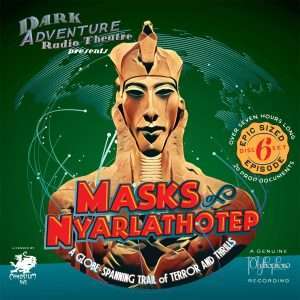 The original campaign was not without its flaws. Much like Indiana Jones and the Temple of Doom, it was a story that took a somewhat too stereotypical view of Native peoples in order to facilitate its Pulp feel. It also was a work that presumed the Investigators would be white male protagonists given the story substantially changes if it’s 1920s men of color or women running around shooting up the place.
The original campaign was not without its flaws. Much like Indiana Jones and the Temple of Doom, it was a story that took a somewhat too stereotypical view of Native peoples in order to facilitate its Pulp feel. It also was a work that presumed the Investigators would be white male protagonists given the story substantially changes if it’s 1920s men of color or women running around shooting up the place.
The campaign also had the flaw of being something of a meatgrinder with stories of whole parties being wiped out a not-uncommon occurrence for Keepers. Generally, the ideal Call of Cthulhu game is player characters investigating sinister goings on, finding a monster, and hopefully having deduced its weakness before using it. Masks of Nyarlathotep is a story best served with Thompson machine guns, two-fisted action, and plenty of dynamite.
As such, I was very excited about hearing that the H.P. Lovecraft Historical Society was going to do an adaptation of the campaign to their Dark Adventure Radio series. The premise of them are that HPL didn’t remain a obscure but beloved magazine author but was adapted to radio like the Shadow and Superman. The radio plays are deliberately Pulpy (I’m going to overuse that word but it’s the best one for it) with dramatic cliffhangers, deliberately ridiculous commercials (asbestos teddy bears!), and overacting. It’s very enjoyable and fits the style of the Call of Cthulhu games greatly. It makes me wish they’d adapt other campaigns like the Horror of the Orient Express.
The radio play is adapted from the 7th Edition rewrite of the module and benefits from having a slightly-more self-aware narrative that acknowledges the racism, sexism, and imperialism of the time. It’s mostly done in a cheeky and humorous style with the assumption being the characters know that colonialism and misogyny is bad. The radio drama doesn’t get into politics as much as the revised module, perhaps for the best given its cheeky half-parody half-serious tone, but it’s still able to diversify the cast as well as show the downside to being a non-white person or woman in the early 20th century.
Hazel Kalifan, one of the protagonists, is a real “Annie Oakley type” and does more as the central heroine to make a statement than any direct statements by the narrative. I’m also fond of her supporting cast in elderly Suffragist Victoria Woodhull, Zeke the manly adventurer who would have been the star decades ago, and Cecil the insurance investigator. The casts of characters rotate quite a bit since a good chunk of the protagonists meet their end before the final episode. This is true to the module but contributes to the audiodrama’s disjointed tone.
The story takes the protagonists from New York to London to Cairo to Kenya and then all the way to Australia before climaxing in Hong Kong. It’s a massive adventure where our protagonists are constantly imperiled by the evil cults and monsters serving the sinister Nyarlathotep (portrayed here as closer to Ming the Merciless or Thulsa Doom than a distant cosmic horror). Our heroes usually manage to stymie the enemy’s plans but rarely without cost. The work is a fully-voiced graphic audio drama rather than a book and has a lot of period- appropriate sound effects to help the story move along. It’s a loving homage to the serialized stories of the Thirties and Forties.
Overall, the story is enjoyable from beginning to end but does suffer a little bit toward the end. The problem boils down to tonal imbalance and mood whiplash. Basically, the story can’t quite decide if it’s a rollicking Pulp adventure or a somber horror story that not everyone is expected to live through. It’s actually true to the original campaign in that respect but the “Kill Em All” heavy body-count by the end (no spoilers on who makes it through and who doesn’t) leaves the ending feeling less triumphant than the climax should be. Mind you, I only played Masks of Nyarlathotep with Pulp Cthulhu rules and heavy modification so maybe my expectations of the story were different.
The Masks of Nyarlathotep radio play was originally only available from the H.P. Lovecraft Historical Society website but is now available on Audible. It should be noted that the cost for the audiobook is thirty-four dollars but, for that price, you can purchase three audiobook credits and it only costs one to get the play. For those readers looking for a budget price on the radio play or simply using common sense, it’s best to use a credit for the book instead of buying it outright. If you want to support the creators then give the extra credits as gifts to friends.
In conclusion, Masks of Nyarlathotep is an amazing radio play that I encourage everyone to check out. It’s about six to seven hours long and is about the length of a decent-sized audiobook. There’s a more expensive version that comes with a lot of props for the adventure
but I didn’t really see the need for that. I’m sure there’s plenty of Call of Cthulhu collectors that would enjoy that.
The post REVIEW: Dark Adventure Radio Theatre: Masks of Nyarlathotep appeared first on Grimdark Magazine.
February 28, 2023
REVIEW: Fire Warrior by Simon Spurrier
In the grim darkness of the far future there is only war. But there are more battlegrounds to wage war on than blasted planetscapes—hearts and minds are just as often at war. And wars for the soul may be the most perilous of all.
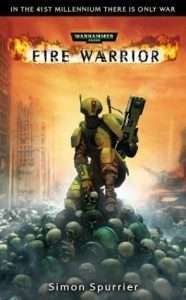 In Fire Warrior by Simon Spurrier we find ourselves witnessing a war that takes place on multiple fronts: a far away planet in a distant star system, the yawning black void of space itself, within the maddening, labyrinthine corridors of a colossal spaceship, and most riveting of all within the mind and heart of a young alien soldier struggling to discover who he is and his place in the universe. Fire Warrior is told through multiple perspectives and shows the reader numerous angles, sometimes even brief snippets of a tertiary perspective just to drive a point home (brief musings of an AI drone in high orbit as it observes a stellar conflict for example, or
In Fire Warrior by Simon Spurrier we find ourselves witnessing a war that takes place on multiple fronts: a far away planet in a distant star system, the yawning black void of space itself, within the maddening, labyrinthine corridors of a colossal spaceship, and most riveting of all within the mind and heart of a young alien soldier struggling to discover who he is and his place in the universe. Fire Warrior is told through multiple perspectives and shows the reader numerous angles, sometimes even brief snippets of a tertiary perspective just to drive a point home (brief musings of an AI drone in high orbit as it observes a stellar conflict for example, or
the last horrific moments of a civilian in a war torn city), but the meat of the story concerns the young fire caste soldier Kais.
Kais is the eponymous fire warrior of Fire Warrior, an individual beset by inner turmoil and turbulence, desperate to navigate the path of their life in accordance to the seemingly impossible expectations set by their legendary father and the singularly overwhelming philosophy of their civilization. From the beginning, Kais is an outsider, and an underdog, who quickly is consumed by the violence and madness of war, enthralled by the bright red seduction of battle, made all the more harrowing when he discovers a shocking aptitude for it. In Fire Warrior we see an individual torn apart by who they are in comparison to who they believe they should be. All the while it is set to the backdrop of outrageous action and colossal set pieces.
Simon Spurrier is a writer with a singular ability to get into the heads of his characters and bring their thoughts and emotions to vivid life, but he also deftly creates scenery and settings that are immensely immersive. What would otherwise feel like exhaustively drawn out passages elsewhere instead become enthralling expositions in the pages of Fire Warrior. The book is hard to put down, the narrative woven together at a breathless pace that leaves your heart thumping as you race to see what could possibly happen next. The action is nonstop, but interwoven with moments of heart ache and tragedy, black humor and philosophy.
Whether you’re a fan of hard-bitten, brutal sci-fi action or a Warhammer 40k diehard, Fire Warrior is a treat not to be missed. More than that, it’s just a damn good time.
Read Fire Warrior by Simon SpurrierThe post REVIEW: Fire Warrior by Simon Spurrier appeared first on Grimdark Magazine.
February 27, 2023
REVIEW: Reclamation by Richard Swan
In Reclamation by Richard Swan, I have found a sci-fi series that scratches that itch left over from The Expanse. Having recently finished Swan’s brilliant fantasy novel The Tyranny of Faith I found myself wanting more of something that was just packed with awesomeness and fun to read. Reclamation delivered what I enjoy reading in absolute spades.
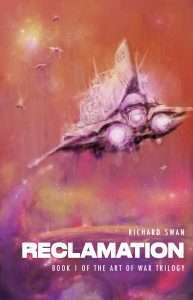 Reclamation is the story of the escalation of political conflict driven in a hundred directions by a range of competing factions. This book is a mixture of political intrigue, espionage, and brutal military conflict. It is a story about biting off more than you can chew, and of the large and powerful becoming rather small and weak. The galaxy is colonised, other species have been met and treated with, but even as humanity has grown into the stars, the things that make humans brilliant to write about because of the conflicts created by our arrogance, greed, and stupidity remain.
Reclamation is the story of the escalation of political conflict driven in a hundred directions by a range of competing factions. This book is a mixture of political intrigue, espionage, and brutal military conflict. It is a story about biting off more than you can chew, and of the large and powerful becoming rather small and weak. The galaxy is colonised, other species have been met and treated with, but even as humanity has grown into the stars, the things that make humans brilliant to write about because of the conflicts created by our arrogance, greed, and stupidity remain.
Lyra is the salvaged head of a UN secret agent (yes, you read that right) who is the starting point for an interstellar incident, and the first storyteller to help us understand the multilayered tale Swan writes. Vondur is a Goliath pilot (I pictured these as epic mech-warriors) we are introduced to during the first major conflict between humankind and the provar (a large and brutal warrior caste species) since they signed their last treaty. He is the lens through which we generally see the military impact of the story. Yano is a diplomat / special envoy heading to a summit called to resolve Provar and Kaygrin (a more insect-like species, weaker and seemingly taken advantage of by both Provar and humanity) hostilites. He’s in the middle of two factions who hate each other at a level he cannot understand, and a hard nosed UN president primarily concerned with what the last few months of his term will leave as his legacy.
In addition to these key characters, a range of further POVs tell the story. All are important, none wasted, and they move the story forward at a Matthew Reilly pace.
Swan uses mystery, character, factional perspective, and misdirection brilliantly to build story. And if he managed this level of layering eight years ago self publishing this series, it’s no bloody wonder he’s achieved what he has with the first two novels of The Empire of the Wolf (The Justice of Kings 2022, The Tyranny of Faith 2023) once he was picked up by Orbit. Reclamation contains utterly magnificent storytelling as we follow the downward spiral of a galaxy.
Reclamation is a magnificent book with an abrupt ending that is either going to leave you throwing the book across the room in frustration, or sitting there smiling and envisaging the repercussions. That is, until you realise book two is already there, waiting for you.
Brilliantly told at a lightning fast pace, and layered with everything fans of space opera, military fantasy, and The Expanse love, Reclamation is a magnificent read that grimdark fans will enjoy. I cannot recommend it enough. Even better? All three books of The Art of War trilogy, a prequel, and two short stories are all already published and waiting for you–and if you’re anything like me, you’re going to want to read them all back-to-back.
Read Reclamation by Richard SwanThe post REVIEW: Reclamation by Richard Swan appeared first on Grimdark Magazine.
February 26, 2023
REVIEW: City of Nightmares by Rebecca Schaeffer
The city buzzes with life in City of Nightmares by Rebecca Schaeffer. Citizens piss on the grimy walls. Pterodactyls fly above tall buildings. Speakeasies hide beneath the city’s secrets while Nightmare hunters fly in from the sky to slay dragons. Casinos shaped like golden dragon eggs encase villains and their sharp smirks. Advertisements promise Newham’s fearful citizens a life of immortality. The world is refreshing, funny, and dark.
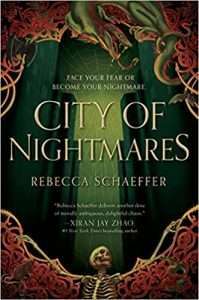 In City of Nightmares, people transform into their worst fears after just one irreversible, slimy nightmare. Every day Ness lives her childhood fear, one bringing back memories of her sister, including the people that died. Ness Crane is just a simple kid trying to stay off the streets. Friends of the Restless Soul is a cult providing door-to-door therapy for families dealing with post-Nightmare trauma. Ness and her best friend hand out nonsense pamphlets to these families in the hope that no one turns into an eldritch horror. Priya is a warrior girl with a gentle, vulnerable side prepared to rip the world apart to protect her friends. Combat boots. Ombre hair. Excited about killing. Priya’s only there until someone turns into a Nightmare, and she can add it to her demon hunter resume. When that day rears its horrifying head, the director of the organization kicks Ness out for repeated mistakes, leaving her with no place to stay. Ness has PTSD and tends to panic first, think later. Surprising absolutely no one, this causes total destruction and chaos wherever she goes.
In City of Nightmares, people transform into their worst fears after just one irreversible, slimy nightmare. Every day Ness lives her childhood fear, one bringing back memories of her sister, including the people that died. Ness Crane is just a simple kid trying to stay off the streets. Friends of the Restless Soul is a cult providing door-to-door therapy for families dealing with post-Nightmare trauma. Ness and her best friend hand out nonsense pamphlets to these families in the hope that no one turns into an eldritch horror. Priya is a warrior girl with a gentle, vulnerable side prepared to rip the world apart to protect her friends. Combat boots. Ombre hair. Excited about killing. Priya’s only there until someone turns into a Nightmare, and she can add it to her demon hunter resume. When that day rears its horrifying head, the director of the organization kicks Ness out for repeated mistakes, leaving her with no place to stay. Ness has PTSD and tends to panic first, think later. Surprising absolutely no one, this causes total destruction and chaos wherever she goes.
Every time this happens, I know it’s going to have consequences. But in those moments, I don’t care. It’s like my mind goes blank, and there’s only the fear.
Ness is a respectable teen, a bonafide scam artist. After a lot of wrangling, the director gives her a job in exchange for a room and a meal. Cy, a kind boy with eyeliner, helps her with a big mail bag. Events lead them onto a boat deck, where Ness very comically threatens Cy with a sample of pepper spray when she believes he’s a blood-sucking vampire about to eat his next victim. In an awkward disaster, Cy helps Ness to shore after a traumatic life-threatening situation. Due to being severely afraid of all Nightmares, Ness expects him to murder her after arriving on shore. He mostly just wants to sleep in the cottage, much to her confusion. That’s the entertaining thing about this book. Every reader wishes they could be the hero but deep down knows they are the disaster coward just trying to make it home for a full eight hours of sleep.
Being the only suspects puts them into a bloody, threatening dilemma. Every reporter is after their story, leaving them trying to solve a mystery in a city swarming with police corruption, conspiracy theories, and cults.
It’s a cruel, dreadful world for teens. They flee their abusive families and parents trying to sell them to harvesters, child-eating Nightmares, and child traffickers. Around them are predators and dangers, every choice on the edge of a knife. Adults create their world, but it’s the kids that are forced into heartbreaking decisions within this monstrous world. Ness and Cy both deal with trauma. Jaded, gay, and passionate about the horrifying way the media portrays content and romance, Cy and Ness dispel that desire is monstrous, that magical creatures are absolved of abuse as so many authors assume in their worldbuilding. Ness, for one, refuses to be any monster’s victim.
Drowning in parties and vice, Cy is the type of character suffering from loneliness after a particularly harrowing childhood. Everyone runs away after discovering he’s a vampire. Those stereotypical images of teeth and blood-sucking get to them over any sense that he might be an individual in control of his actions. He wants, hopes, to be Ness’s friend. One of the highlights of City of Nightmares is seeing how their friendship develops. It’s the classical reason readers still eat up SFF. The threat of gargantuan monsters in a city is without a doubt a plus, but it’s the friendships that make readers stay.
The story in City of Nightmares is about trust, a kind honest human connection between friends. Amongst all the eldritch horror references, readers will love the bond between Cy and Ness, who pack a quick jab for every response. There’s a similar understanding of trauma between them, one that allows for bonding over their experiences into something more about love over the horror of their past. Society doesn’t value friendship nearly enough. This is the type of friendship that makes a reader grab for the tissues more than a blood-drenched death.
It’s also worth a shout-out that Schaffer is deliberate in all her decisions. It is not an untrue statement to say that fantasy authors often forget that skin color means describing everyone. Black, brown, and white characters are described with the understanding that they exist in this world. Schaeffer points out a character’s skin color over the myth of colorblindness which has historically consumed the fantasy genre. Her world feels fuller, more like the real world, due to this choice.
City of Nightmares is a gleeful mixture of dark fantasy, sharp waistcoats, and humor. The characters go through hell, and they are worth every word. If you’re a fan of Gotham-inspired worlds, The Locked Tomb, or monsters wreaking havoc, City of Nightmares should be on your shopping cart. Any Grimdark parents looking to get their teens into dark fantasy would be remiss to miss this gem.
Rating: 4 Stars
Read City of Nightmares by Rebecca SchaefferThe post REVIEW: City of Nightmares by Rebecca Schaeffer appeared first on Grimdark Magazine.



